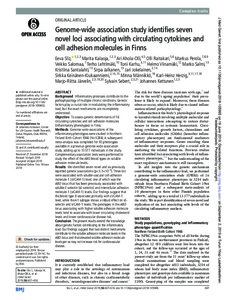Genome-wide association study identifies seven novel loci associating with circulating cytokines and cell adhesion molecules in Finns
Sliz E.; Kalaoja M.; Ahola-Olli A.; Raitakari O.; Perola M.; Salomaa V.; Lehtimäki T.; Karhu T.; Viinamäki H.; Salmi M.; Santalahti K.; Jalkanen S.; Jokelainen J.; Keinänen-Kiukaanniemi S.; Männikkö M.; Herzig K.-H.; Järvelin M.-R.; Sebert S.; Kettunen J.
https://urn.fi/URN:NBN:fi-fe2021042824787
Tiivistelmä
Background: Inflammatory processes contribute to the pathophysiology of multiple chronic conditions. Genetic factors play a crucial role in modulating the inflammatory load, but the exact mechanisms are incompletely understood.
Objective: To assess genetic determinants of 16 circulating cytokines and cell adhesion molecules (inflammatory phenotypes) in Finns.
Methods: Genome-wide associations of the inflammatory phenotypes were studied in Northern Finland Birth Cohort 1966 (N=5284). A subsequent meta-analysis was completed for 10 phenotypes available in a previous genome-wide association study, adding up to 13 577 individuals in the study. Complementary association tests were performed to study the effect of the ABO blood types on soluble adhesion molecule levels.
Results: We identified seven novel and six previously reported genetic associations (p<3.1×10−9). Three loci were associated with soluble vascular cell adhesion molecule-1 (sVCAM-1) level, one of which was the ABO locus that has been previously associated with soluble E-selectin (sE-selectin) and intercellular adhesion molecule-1 (sICAM-1) levels. Our findings suggest that the blood type B associates primarily with sVCAM-1 level, while the A1 subtype shows a robust effect on sE-selectin and sICAM-1 levels. The genotypes in the ABO locus associating with higher soluble adhesion molecule levels tend to associate with lower circulating cholesterol levels and lower cardiovascular disease risk.
Conclusion: The present results extend the knowledge about genetic factors contributing to the inflammatory load. Our findings suggest that two distinct mechanisms contribute to the soluble adhesion molecule levels in the ABO locus and that elevated soluble adhesion molecule levels per se may not increase risk for cardiovascular disease.
Kokoelmat
- Rinnakkaistallenteet [27094]
